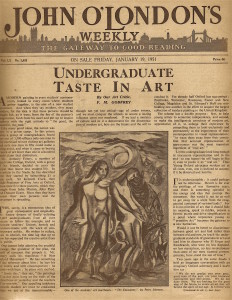 Thus begins the front page article published in the January 19th 1951 issue of John O’London’s Weekly. In it the art critic F.M.Godfrey recounts the campaign of Anthony Emery, a mature undergraduate at Pembroke College, Oxford, to supply examples of modern art for the Common rooms, hostels and Unions used by every undergraduate in Britain.
Thus begins the front page article published in the January 19th 1951 issue of John O’London’s Weekly. In it the art critic F.M.Godfrey recounts the campaign of Anthony Emery, a mature undergraduate at Pembroke College, Oxford, to supply examples of modern art for the Common rooms, hostels and Unions used by every undergraduate in Britain.
The crusade to inspire students with the right attitude to ‘ the good, the beautiful and true’ had begun just after the war at Emery’s own college, where, shocked by the ignorance of modern art shown by serving officers, he ( a wartime officer ) and some like-minded friends had pledge to subscribe a £1 each to established a small collection for their common room. Inspired by the guidance of Sir Kenneth Clark, who had chosen for them a painting each by John Minton, John Piper and Duncan Grant, they had gone on to choose their own pictures.
As Godfrey remarks, Emery’s manifesto, which he called ‘A New Oxford Movement’ had the spirit of the reformer about it. And Godfrey himself echoed his sentiments.
‘Our appalling ignorance towards modern art must be eradicated when we are at the impressionable …age of under twenty, and we must conquer the schools to secure a lasting influence upon our manhood. If we had a ministry of culture and in it a department for the dissemination of modern art, here are the brains and the will to conduct it. For already half of Oxford has succumbed: Pembroke, Worcester, Brasenose, Exeter and New College, Magdalen and St Edmund’s Hall are outbidding one another in the effort to acquire the largest collection of modern painting in the United Kingdom ‘.
The idea behind this enterprise, according to Emery, was to ‘wean’ undergraduates away from their conviction that accurate representation of appearances was the most important ingredient of ‘real art’. The response of Godfrey to this statement of youthful rebellion against conventional art was to argue that there was a danger if impressionable minds looked only at art that sought to ‘ hide its meaning, speak in riddles, present a formal puzzle and drive simplification to a point where impotence posing as “primitive Art” becomes that gateway to a new barbarism.’
If young art-lovers saw meaning only in art of their own time, Godfrey argued, they were in danger of losing perspective. Undergraduates should understand that Old Masters, despite the fact that they perhaps lived in a less challenging world, had important messages to convey and that these could be communicated if framed colour reproductions of their work were made available to students. They would then understand that ‘Art does not grow in a vacuum of isolated endeavour. Cezanne derived from Courbet, Degas from Ingres, Manet from Velasquez.’ Indeed, he went on, those who weren’t privileged to study surrounded by art of the past, should also be urged to gain a balanced appreciation of all art through ‘constant intercourse with different schools and individual masters’.
Today this excellent point would be understood by students of art history, but perhaps might, alas, be dismissed by most untutored lovers of contemporary art as ‘old fashioned ‘ or ‘uncool’.
Incidentally, Cambridge copied Oxford to some extent a few years later, when undergraduates were offered the chance by Kettle’s Yard to ‘hire’ paintings by such modern masters as Ben Nicholson and Alfred Wallis for their bedrooms. This scheme was discontinued after a while—perhaps for the reasons offered by Godfrey—but more likely because the paintings had become too valuable to loan out. [R.M.Healey]
